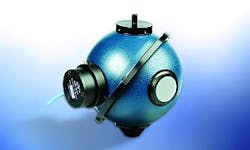Newport integrating spheres handle up to 10 W of optical power
The Series 819C/D integrating spheres operate from the UV to the near-infrared (NIR), and can handle up to 10 W of optical power. Available for both diverging (819C) and collimated (819D) input beams, the line extension to UV make the spheres suitable for optical power measurement applications. Sensor materials include silicon (Si) for detection between 400–1100 nm; UV-enhanced Si optimized for 200–400 nm (but calibrated up to 1100 nm); and indium gallium arsenide (InGaAs), which operates in the 800–1650 nm range. Available sizes range from 2 to 5.3 in.
Newport (MKS Instruments)
Irvine, CA
www.newport.com/819
-----
PRESS RELEASE
Newport Introduces Integrating Spheres Series 819C/D
Irvine, CA – Newport Corporation, an industry leader in optical power measurement, introduces the Series 819C/D high power silicon-based integrating sphere detectors which operate in the ultraviolet (UV- down to 200 nm) and can handle up to 10 watts of optical power. The new CAL2 models feature a built-in temperature sensor and OD1 attenuator sensor. When connected to Newport’s power meter models 1830-R, 1918-R, 1936-R, or 2936-R, they automatically recognize the attenuator On/Off position and the detector head temperature.
Calibrated and traceable to NIST standards, the 819C/D Series spheres operate in wavelengths ranging from the UV region through the visible to the near-infrared (NIR) at 1650 nm. The detectors offer superior and accurate measurements with the market’s smallest calibration uncertainty specifications. Available for both diverging (model 819C) and collimated (model 819D) input beams, the line extension to UV and higher-power features make this series an essential tool for critical optical power measurement applications.
There are three sensor materials used in the new integrating spheres series. They include silicon (Si), for detection between 400 - 1100 nm; UV-enhanced Si, optimized for 200 - 400 nm (but calibrated up to 1100 nm); and indium gallium arsenide (InGaAs) which operates in the 800 - 1650 nm wavelength range. Available sphere sizes range from 2-in. to 5.3-in. spheres.
For added functionality, all spheres come with an SMA fiber optic connector on the north pole as a standard feature. This permits a small amount of light pickoff for wavelength measurement or any further analysis, without affecting the overall system calibration. For more information about Newport’s advanced integrating sphere detector series, please go to www.newport.com/819.
About Newport Corporation
Newport Corporation is a leading global supplier of advanced-technology products and systems to customers in the scientific research, microelectronics manufacturing, aerospace and defense/security, life and health sciences and precision industrial manufacturing markets. Newport’s innovative solutions leverage its expertise in high-power semiconductor, solid-state and ultrafast lasers, photonics instrumentation, sub-micron positioning systems, vibration isolation, optical subsystems and precision automation to enhance the capabilities and productivity of its customers’ manufacturing, engineering and research applications. Newport is part of the Standard & Poor’s SmallCap 600 Index and the Russell 2000 Index.
-----
Follow us on Twitter
Subscribe now to Laser Focus World magazine; it's free!
